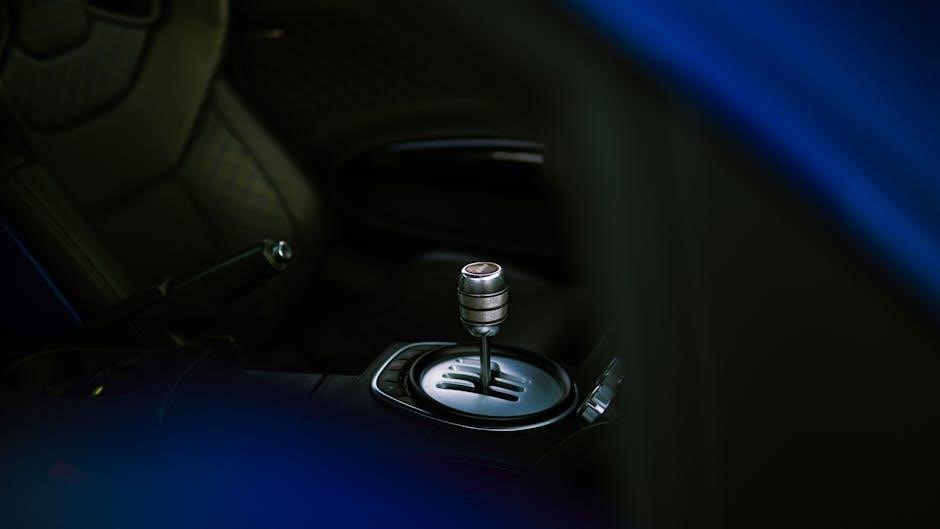Cummins engines, known for their power and durability, often pair with manual transmissions for enhanced driver control and efficiency. These transmissions are popular in heavy-duty applications, offering precise gear shifts that optimize performance, especially in towing and hauling scenarios. Unlike automatics, manual transmissions provide direct control over torque delivery, making them a preferred choice for drivers seeking both fuel efficiency and mechanical connection. This combination of Cummins’ robust engine technology with a manual gearbox creates a reliable and cost-effective solution for demanding automotive needs.
1.1 Overview of Cummins Engines
Cummins engines are renowned for their robust design and reliability, making them a preferred choice for heavy-duty trucks. Known for high torque output and fuel efficiency, these engines are widely used in industrial and automotive applications. The 5.9L and 6.7L Cummins engines are particularly popular for their durability and performance in towing and hauling scenarios. Their reputation for longevity and power has solidified their position as a trusted option for drivers seeking dependable machinery. This legacy contributes to their compatibility with manual transmissions, enhancing overall vehicle performance and driver control.
1.2 Importance of Manual Transmissions in Cummins Engines
Manual transmissions play a crucial role in maximizing the performance and efficiency of Cummins engines. They provide drivers with precise control over gear shifts, enabling optimal torque delivery, especially during heavy-duty tasks like towing and hauling. Unlike automatics, manuals offer better fuel economy and lower operating costs, making them a cost-effective choice. Additionally, manual transmissions reduce the need for complex electronics, enhancing reliability and minimizing potential failures. This mechanical simplicity aligns perfectly with the durable and powerful nature of Cummins engines, creating a reliable and efficient driving experience.

Popular Manual Transmissions for Cummins Engines
Cummins engines are often paired with the G56 and Getrag manual transmissions, known for their durability and smooth gear engagement, making them ideal for heavy-duty applications.
2.1 G56 Manual Transmission
The G56 manual transmission is a popular choice for Cummins engines, offering six forward speeds and a reverse gear. Known for its robust design, it handles high torque outputs effectively, making it ideal for heavy-duty applications like towing and hauling. With a strong gear set and smooth shifting, the G56 enhances driving performance while maintaining fuel efficiency. It’s widely regarded for its reliability and is often preferred by drivers seeking precise control over their vehicle’s power delivery.
2.2 Getrag Manual Transmission
The Getrag manual transmission is a durable and reliable option for Cummins engines, offering a six-speed design that handles high torque outputs efficiently. Known for its robust construction, it is widely used in various Cummins-powered vehicles, particularly in European markets. The Getrag transmission features a strong gear set, smooth shifting, and a compact design, making it suitable for both on-road and off-road applications. Its lightweight construction and precise control contribute to improved fuel efficiency and driving performance, ensuring a balance between power and versatility.

Benefits of Manual Transmission in Cummins Engines
Manual transmissions in Cummins engines offer improved fuel efficiency, enhanced driver control, and better torque management, making them ideal for heavy-duty applications like towing and hauling.
3.1 Fuel Efficiency
Manual transmissions in Cummins engines are renowned for their ability to enhance fuel efficiency, particularly in heavy-duty applications. By eliminating the parasitic losses associated with automatic transmissions, manual gearboxes allow for more direct power transfer, reducing fuel consumption. Drivers can optimize shifting techniques to maintain optimal engine RPMs, further improving mileage. This makes manual transmissions a cost-effective and environmentally friendly choice, especially for long-haul and towing scenarios where fuel efficiency is critical.
3.2 Driver Control and Performance
Manual transmissions in Cummins engines deliver exceptional driver control and performance. They allow precise gear selection, enabling optimal engine RPM management for enhanced power delivery. This direct mechanical connection between the driver and the engine fosters a more engaging and responsive driving experience. Manual transmissions excel in towing and hauling scenarios, where maintaining control over torque and speed is crucial. The absence of automatic slippage ensures faster acceleration and improved responsiveness, making manual transmissions a preferred choice for drivers seeking both power and precision.

Installation and Setup
Installing a manual transmission in a Cummins engine requires precise alignment of components like the shift tower, clutch, and flywheel. Proper setup ensures smooth engagement and reliability.
4.1 Step-by-Step Installation Guide
Installing a Cummins manual transmission involves several precise steps. Start by removing the old transmission and inspecting the bellhousing. Next, install the new transmission, ensuring proper alignment with the engine. Reconnect the clutch, flywheel, and hydraulics, followed by the shift tower and crossmember. Reattach the driveshaft and ensure all bolts are torqued to specifications. Finally, test the system by shifting through gears to confirm smooth operation. Always consult the service manual for specific instructions and torque values.
4.2 Compatibility with Cummins Engines
Cummins manual transmissions are specifically designed to pair seamlessly with Cummins engines, ensuring optimal performance and durability. The G56 and Getrag transmissions are popular choices, engineered to handle the high torque output of Cummins engines. Compatibility varies by engine model, with the 5.9L and 6.7L engines being common pairings. Proper alignment of the bellhousing and clutch system is crucial for a smooth connection. Always verify compatibility with your Cummins engine model and consult the service manual for specific installation requirements.

Maintenance and Upkeep
Regular maintenance for Cummins manual transmissions includes checking fluid levels, inspecting for leaks, ensuring proper lubrication, scheduling regular servicing, and following the service manual.
5.1 Regular Maintenance Tips
Regular maintenance is crucial for extending the life of your Cummins manual transmission. Check fluid levels consistently, inspect for leaks, and ensure proper lubrication. Schedule routine servicing with a qualified technician to identify potential issues early. Follow the service manual guidelines for fluid changes and component inspections. Monitor shift quality and address any unusual noises or resistance promptly. Keeping detailed maintenance records helps track servicing history and ensures compliance with manufacturer recommendations.
5.2 Common Issues and Solutions
Common issues with Cummins manual transmissions include difficulty shifting gears, unusual noises, and high mileage wear. For shifting problems, check the clutch and transmission fluid levels, and ensure synchronizers are functioning properly. Noises like grinding or clunking may indicate worn gears or bearings, requiring inspection and potential replacement. High mileage can lead to worn components like the clutch and pressure plate, which may need replacement to maintain performance. Regular inspections and timely repairs can prevent major breakdowns and extend transmission life.
Driving Techniques
Mastering smooth acceleration and gradual shifting enhances fuel efficiency and performance. Listen to engine RPMs to avoid lugging or over-revving, ensuring optimal power delivery and transmission longevity.
6.1 Shifting Techniques for Cummins Manual Transmissions
Smooth acceleration and precise shifting are key to optimizing Cummins manual transmissions. Use the clutch pedal gradually, avoiding sudden disengagement. Shift gears based on engine RPM levels to prevent lugging or over-revving. Downshift before uphill climbs to maintain control and leverage engine braking. Listen to the engine’s tone to guide seamless transitions between gears, ensuring efficient power delivery and reducing wear on the gearbox. Proper technique enhances both performance and transmission longevity.
6.2 Optimizing Performance While Driving
Optimizing performance with a Cummins manual transmission involves monitoring RPM levels to avoid lugging or over-revving. Use the correct gear for load and speed conditions, ensuring smooth transitions. Avoid aggressive downshifting; instead, feather the clutch for gradual deceleration. Engine braking on downhill slopes can reduce wear on brakes while maintaining control. Keep shifts deliberate and precise to maximize torque delivery and fuel efficiency, especially during towing or hauling. This approach enhances both performance and transmission longevity.
Troubleshooting Common Problems
Cummins manual transmissions may experience issues like rough shifting or unusual noises. Common problems include worn clutch packs or faulty synchronizers. Regular inspection and timely repairs ensure optimal performance and longevity.
7.1 Identifying and Diagnosing Issues
Identifying issues in Cummins manual transmissions starts with observing symptoms like unusual noises, difficulty shifting gears, or vibrations. Diagnosing involves checking fluid levels, inspecting for worn components, and using diagnostic tools to pinpoint faults. Regular maintenance, such as examining the clutch and synchronizers, helps prevent major problems. Early detection ensures timely repairs, avoiding costly overhauls and extending the transmission’s lifespan. Always refer to service manuals for accurate troubleshooting steps.
7.2 Repair and Replacement Options
Repairing a Cummins manual transmission often involves replacing worn components like synchronizers or bearings. For major damage, a complete rebuild or replacement may be necessary; DIY repairs can be cost-effective but require mechanical expertise. Professional shops offer comprehensive solutions, ensuring proper alignment and functionality. Replacement parts should be genuine Cummins components for optimal performance. Regular maintenance can prevent costly repairs, but when issues arise, prompt action is essential to avoid further damage and ensure reliable operation.
Future of Manual Transmissions in Cummins Engines
Advancements in transmission technology and shifting market demands may influence the future of manual transmissions for Cummins engines, balancing efficiency with driver preference for control and durability.
8.1 Trends in Transmission Technology
Recent advancements in manual transmission technology for Cummins engines include improved synchronous designs, lightweight materials, and integrated clutch systems. These innovations enhance durability and performance while reducing weight and improving fuel efficiency. Additionally, advancements in gear ratios and smart shifting algorithms optimize power delivery, making manual transmissions more competitive in a market dominated by automatics. These trends ensure that manual transmissions remain a viable option for drivers seeking precision and control in their Cummins-powered vehicles.
8.2 Market Demand for Manual Transmissions
Despite the rise of automatic transmissions, manual transmissions for Cummins engines maintain a niche demand, particularly among enthusiasts and professionals requiring precise control. The preference for manual transmissions is driven by their fuel efficiency, lower cost, and superior performance in towing and hauling applications. While automatics dominate the market, manuals continue to attract those who value driver engagement and mechanical simplicity, ensuring steady demand in specific sectors and regions.
Resources and Manuals
Cummins provides extensive resources, including service manuals and parts catalogs, through platforms like QuickServe Online (QSOL). Registration on ePortal.net is required for access to these materials.
9.1 Accessing Cummins Service Manuals
Accessing Cummins service manuals requires registration on the ePortal.net platform. Once registered, users can utilize QuickServe Online (QSOL) to find detailed diagnostic procedures, maintenance schedules, and parts information. These manuals are essential for understanding and servicing Cummins engines, including those paired with manual transmissions. Additionally, wiring diagrams and service bulletins are available, providing comprehensive support for repairs and upkeep. Ensure to use the Engine Serial Number (ESN) for precise information retrieval.
9.2 Online Communities and Forums
Online forums and communities are invaluable resources for Cummins manual transmission owners. Platforms like diesel forums, Reddit groups, and specialized truck communities offer expert advice, troubleshooting tips, and real-world experiences. These spaces allow users to connect with mechanics and enthusiasts, sharing knowledge on maintenance, upgrades, and common issues. Active participation can provide solutions, industry insights, and access to rare repair guides, making them indispensable for optimizing and maintaining Cummins manual transmissions effectively.
Cummins manual transmissions offer unmatched fuel efficiency, driver control, and durability, making them a top choice for heavy-duty applications. Their continued relevance underscores their enduring value and performance.
10.1 Summary of Key Points
Cummins manual transmissions are renowned for their fuel efficiency, driver control, and durability, making them ideal for heavy-duty applications. Proper installation and regular maintenance ensure optimal performance. Troubleshooting common issues and understanding transmission technology trends are crucial for long-term reliability. The combination of Cummins engines with manual transmissions provides a cost-effective solution for towing and hauling, highlighting their continued relevance in the automotive industry.
10.2 Final Thoughts on Cummins Manual Transmissions
Cummins manual transmissions remain a favored choice for drivers seeking fuel efficiency, driver control, and durability. While modern automatics dominate the market, manuals offer a unique mechanical connection and cost-effectiveness. Proper installation, maintenance, and understanding of transmission technology ensure long-term performance. For those prioritizing precision and reliability, Cummins manual transmissions continue to be a robust and dependable option, catering to both seasoned enthusiasts and practical users alike.
